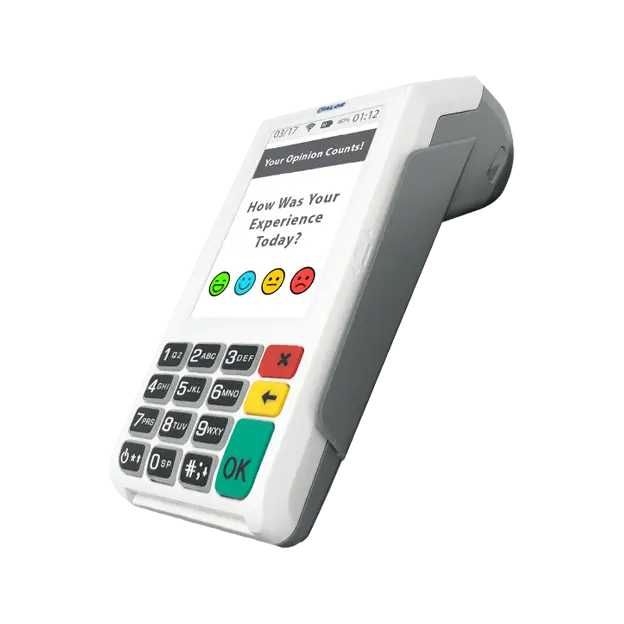
In today’s digital age, businesses and consumers are increasingly relying on smart terminals for efficient payment processing. But with the rise of technology comes the inevitable question: how secure are these smart terminals for handling customer payments? This blog aims to break down this concern and offer clear insights into the security measures surrounding smart terminals.
Understanding Smart Terminal Technology
Smart terminals are technologically advanced devices that combine traditional point-of-sale capabilities with the flexibility of software applications. They offer businesses a streamlined way to handle transactions but also raise concerns about data security.
The evolution of smart terminals is driven by the need for efficiency and security in payment processing. Modern smart terminals, such as those using Wi-Fi or cellular networks, integrate seamlessly into any business environment, whether it’s a bustling retail store or an outdoor event. These devices have revolutionized how businesses accept payments by enabling portable and flexible transaction processing, all while keeping a close eye on protecting sensitive information.
A significant advantage of smart terminals is their ability to process transactions both offline and online. This dual capability ensures that businesses can continue to operate even during network outages. Coupling this with customized applications, businesses can easily manage inventory, track sales, and enhance customer interactions all through one device.
The integration of contactless payment technology, like NFC, not only speeds up transactions but reduces physical contact, enhancing both security and customer satisfaction. With features such as real-time data analytics available on many smart terminals, businesses can gain insights into customer behavior, thereby optimizing their operations.
What Security Features Do Smart Terminals Offer?
Smart terminals come equipped with various security features such as encryption, tokenization, and secure authentication protocols that protect payment data during transactions. These features help prevent data breaches and fraud.
Encryption is a cornerstone of smart terminal security, transforming sensitive data into an unreadable format that can only be decoded with the correct key. According to the Definitive Guide to Smart Terminals, this type of protection guards against unauthorized access during data transmission while also reinforcing customer trust.
Tokenization adds another layer of safety by substituting sensitive card details with unique identifiers or tokens. These tokens are meaningless if intercepted, further limiting the potential for data misuse. This approach is especially critical in mitigating the effects of potential data breaches by ensuring that the actual card information remains secure.
Authentication protocols, like multi-factor authentication and biometric verification, play an essential role in smart terminal security. By requiring more than just a password for access, these protocols ensure that only authorized users can interact with the payment system, reducing the risk of tampering or data theft.
Security compliance with standards like PCI DSS ensures that smart terminals adhere to the necessary guidelines for safeguarding payment card data. This compliance is crucial not only for legal protection but also for maintaining customer confidence in a business’s commitment to data security.
Common Security Concerns with Smart Terminals
Despite robust security measures, smart terminals can still be vulnerable to certain risks such as hacking or physical tampering. Understanding these potential vulnerabilities is key to mitigating them effectively.
One significant concern is the interception of wireless signals during data transmission. As indicated in our exploration of wireless terminal safety, businesses should employ secure networks and robust encryption to prevent unauthorized network access.
Physical security is another challenge, as devices left unattended or unsecured can be tampered with. Ensuring that terminals are properly secured when not in use and implementing monitoring protocols can help protect against such threats.
Businesses should also be aware of the threat of rogue devices mimicking legitimate networks to intercept data. Continuous monitoring of network connections and regular security assessments can help in identifying and responding to such risks.
How to Enhance the Security of Smart Terminals
Businesses can further increase the security of smart terminals by regularly updating software, training employees on security best practices, and conducting thorough security assessments to stay ahead of potential threats.
Implementing regular software updates is essential in protecting against new cyber threats. These updates often include patches and new security features that fortify the terminal’s defenses against potential vulnerabilities.
Training employees on recognizing and responding to security threats is equally important. Employees who understand how to handle sensitive data correctly and identify suspicious activity can serve as the first line of defense against cybersecurity breaches.
Routine security audits and risk assessments enable businesses to identify weaknesses within their systems and take corrective actions promptly. These assessments should include penetration testing and a review of access controls to ensure only authorized personnel can interact with payment processing systems.
The Importance of Compliance with Security Standards
Adhering to industry standards such as PCI DSS (Payment Card Industry Data Security Standard) is crucial for businesses using smart terminals. Compliance ensures that businesses maintain a high standard of security for processing payment information.
PCI DSS compliance outlines a comprehensive set of security requirements designed to protect cardholder data and safeguard against fraud. By implementing these standards, businesses signal their commitment to maintaining a secure payment environment.
Businesses that achieve compliance benefit from enhanced reputation and customer trust. Compliance demonstrates a proactive approach to data security, ultimately fostering long-term customer relationships and reducing the risk of data breaches.
Being compliant also protects businesses from legal and financial repercussions associated with data breaches. It provides a roadmap for maintaining robust security measures, ensuring that payment data remains protected at all times.
Ensuring Secure Transactions with Smart Terminals
In conclusion, while smart terminals offer impressive convenience and efficiency, their security is paramount for protecting customer payment information. By understanding the implemented security features and staying aware of potential threats, businesses can ensure that they provide a safe payment experience for their customers.

